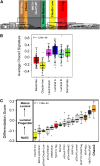Comparative oncogenomics implicates the neurofibromin 1 gene (NF1) as a breast cancer driver
- PMID: 22851646
- PMCID: PMC3454871
- DOI: 10.1534/genetics.112.142802
Comparative oncogenomics implicates the neurofibromin 1 gene (NF1) as a breast cancer driver
Abstract
Identifying genomic alterations driving breast cancer is complicated by tumor diversity and genetic heterogeneity. Relevant mouse models are powerful for untangling this problem because such heterogeneity can be controlled. Inbred Chaos3 mice exhibit high levels of genomic instability leading to mammary tumors that have tumor gene expression profiles closely resembling mature human mammary luminal cell signatures. We genomically characterized mammary adenocarcinomas from these mice to identify cancer-causing genomic events that overlap common alterations in human breast cancer. Chaos3 tumors underwent recurrent copy number alterations (CNAs), particularly deletion of the RAS inhibitor Neurofibromin 1 (Nf1) in nearly all cases. These overlap with human CNAs including NF1, which is deleted or mutated in 27.7% of all breast carcinomas. Chaos3 mammary tumor cells exhibit RAS hyperactivation and increased sensitivity to RAS pathway inhibitors. These results indicate that spontaneous NF1 loss can drive breast cancer. This should be informative for treatment of the significant fraction of patients whose tumors bear NF1 mutations.
Figures





Similar articles
-
Mouse Models of Breast Cancer Share Amplification and Deletion Events with Human Breast Cancer.J Mammary Gland Biol Neoplasia. 2017 Mar;22(1):71-84. doi: 10.1007/s10911-017-9374-y. Epub 2017 Jan 26. J Mammary Gland Biol Neoplasia. 2017. PMID: 28124185 Free PMC article.
-
Comparative oncogenomics identifies combinations of driver genes and drug targets in BRCA1-mutated breast cancer.Nat Commun. 2019 Jan 23;10(1):397. doi: 10.1038/s41467-019-08301-2. Nat Commun. 2019. PMID: 30674894 Free PMC article.
-
Concurrent DNA Copy-Number Alterations and Mutations in Genes Related to Maintenance of Genome Stability in Uninvolved Mammary Glandular Tissue from Breast Cancer Patients.Hum Mutat. 2015 Nov;36(11):1088-99. doi: 10.1002/humu.22845. Epub 2015 Aug 14. Hum Mutat. 2015. PMID: 26219265
-
Neurofibromatosis 1: closing the GAP between mice and men.Curr Opin Genet Dev. 2003 Feb;13(1):20-7. doi: 10.1016/s0959-437x(02)00015-1. Curr Opin Genet Dev. 2003. PMID: 12573431 Review.
-
NF1 and Neurofibromin: Emerging Players in the Genetic Landscape of Desmoplastic Melanoma.Adv Anat Pathol. 2017 Jan;24(1):1-14. doi: 10.1097/PAP.0000000000000131. Adv Anat Pathol. 2017. PMID: 27941538 Review.
Cited by
-
Point-activated ESR1Y541S has a dramatic effect on the development of sexually dimorphic organs.Genes Dev. 2020 Oct 1;34(19-20):1304-1309. doi: 10.1101/gad.339424.120. Epub 2020 Sep 10. Genes Dev. 2020. PMID: 32912899 Free PMC article.
-
The Predictive and Prognostic Role of RAS-RAF-MEK-ERK Pathway Alterations in Breast Cancer: Revision of the Literature and Comparison with the Analysis of Cancer Genomic Datasets.Cancers (Basel). 2022 Oct 28;14(21):5306. doi: 10.3390/cancers14215306. Cancers (Basel). 2022. PMID: 36358725 Free PMC article. Review.
-
Single allele loss-of-function mutations select and sculpt conditional cooperative networks in breast cancer.Nat Commun. 2021 Sep 2;12(1):5238. doi: 10.1038/s41467-021-25467-w. Nat Commun. 2021. PMID: 34475389 Free PMC article.
-
Variation Analysis in Premenopausal and Postmenopausal Breast Cancer Cases.J Pers Med. 2024 Apr 20;14(4):434. doi: 10.3390/jpm14040434. J Pers Med. 2024. PMID: 38673061 Free PMC article.
-
Genomic Alterations Correlated to Trastuzumab Resistance and Clinical Outcomes in HER2+/HR- Breast Cancers of Patients Living in Northwestern China.J Cancer. 2024 Jun 17;15(14):4467-4476. doi: 10.7150/jca.84832. eCollection 2024. J Cancer. 2024. PMID: 39006074 Free PMC article.
References
-
- Arima Y., Hayashi H., Kamata K., Goto T. M., Sasaki M., et al. , 2009. Decreased expression of neurofibromin contributes to epithelial-mesenchymal transition in neurofibromatosis type 1. Exp. Dermatol. 19: e136–e141 - PubMed
-
- Bajenaru M. L., Donahoe J., Corral T., Reilly K. M., Brophy S., et al. , 2001. Neurofibromatosis 1 (NF1) heterozygosity results in a cell-autonomous growth advantage for astrocytes. Glia 33: 314–323 - PubMed
-
- Carey L. A., Perou C. M., Livasy C. A., Dressler L. G., Cowan D., et al. , 2006. Race, breast cancer subtypes, and survival in the Carolina Breast Cancer Study. JAMA 295: 2492–2502 - PubMed
Publication types
MeSH terms
Substances
Grants and funding
LinkOut - more resources
Full Text Sources
Other Literature Sources
Medical
Molecular Biology Databases
Research Materials
Miscellaneous

